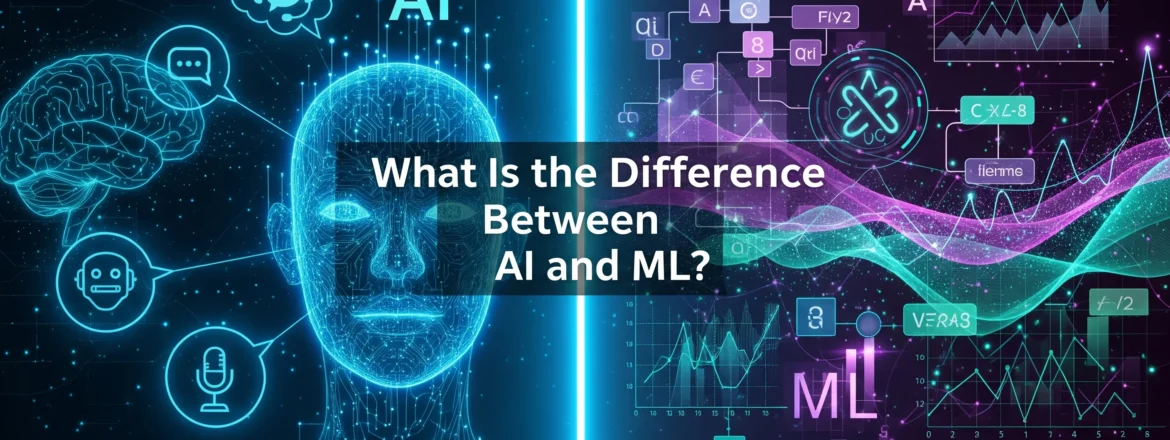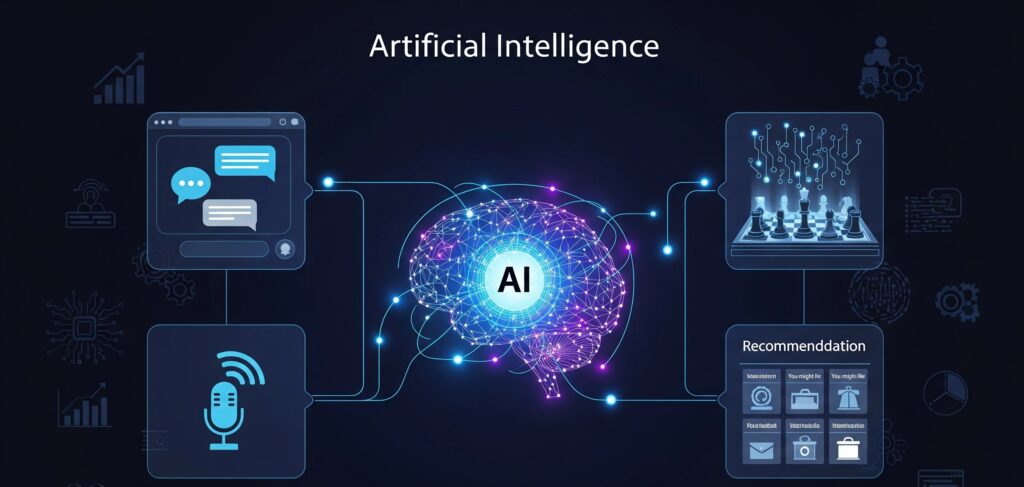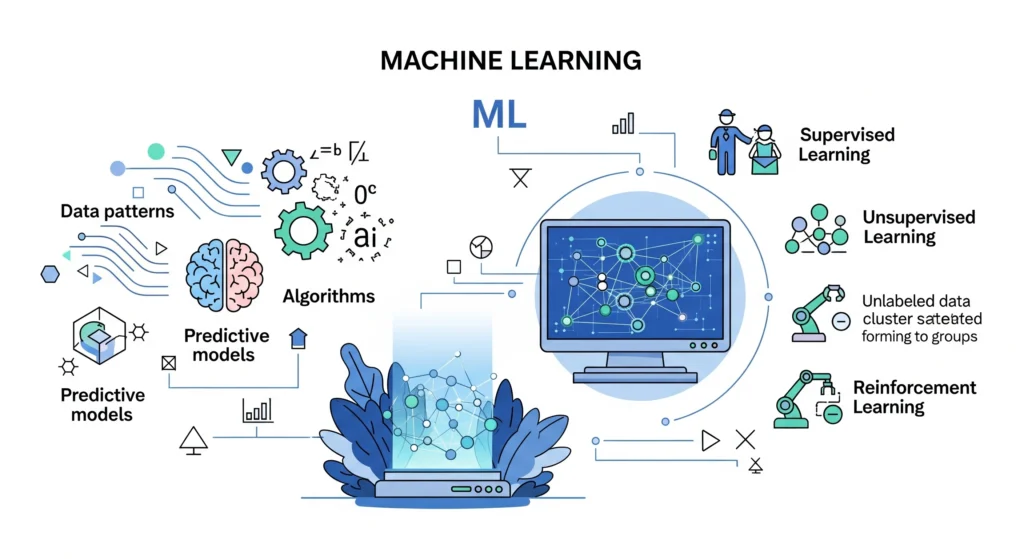
- By: Atif Latest News /
What Is the Difference Between AI and ML?
Many people use the terms artificial intelligence (AI) and machine learning (ML) as if they mean the same thing, but that creates a lot of confusion. You might wonder why businesses, tech leaders, and even everyday conversations keep throwing both words around without a clear explanation.
The truth is, AI and ML are connected but not identical. Knowing the difference makes it easier to see how each technology shapes the apps we use, the businesses we run, and even the recommendations we get online.
In this article, we’ll walk through what AI really is, how ML fits within it, and the specific ways they differ. By the end, you’ll not only understand the distinction but also see how both can be applied in real-world scenarios to bring smarter solutions to industries everywhere.
Comparison Table
Feature | Artificial Intelligence | Machine Learning |
Scope | Broad | Subset of AI |
Goal | Simulate human intelligence | Learn patterns from data |
Approach | Rules, logic, knowledge | Algorithms, statistics, models |
Adaptability | Can be static or adaptive | Learns and improves automatically |
Examples | Chatbots, Virtual Assistants | Recommendation Engines, Fraud Detection |
What Is Artificial Intelligence?
Artificial intelligence is the field of computer science dedicated to building systems capable of performing tasks that typically require human intelligence. These tasks include problem-solving, reasoning, language understanding, and decision-making. AI spans narrow AI, which is task-specific, and general AI, which is more advanced and can perform multiple tasks like a human.
In simpler terms, AI is about making machines “think” in ways that mimic human cognitive functions. While full general AI is still largely theoretical, narrow AI powers most practical applications today. At XtreemeTech, we leverage AI to create solutions that automate workflows, enhance decision-making, and improve overall business efficiency.
Examples
Chatbots: Companies use AI-powered chatbots to answer customer queries instantly, reducing wait times and enhancing service quality.
Virtual Assistants: Siri, Alexa, and Google Assistant can understand spoken language, schedule tasks, and control smart devices.
Game-Playing Systems: AI systems like AlphaGo and DeepMind beat human players in complex games by processing millions of possible moves and predicting outcomes.
Recommendation Systems: AI algorithms suggest products or content based on user preferences, improving engagement on platforms like Netflix and Amazon.
These examples highlight AI’s versatility, it’s not just automation; it’s intelligent automation that adapts to user needs.

What Is Machine Learning?
Machine learning is a subset of AI that focuses on developing algorithms that allow computers to learn from data. Unlike traditional programming, ML systems don’t require explicit instructions for every scenario, they identify patterns and make predictions based on past experience.
ML essentially teaches machines to learn by example, which is what makes it a cornerstone of modern AI applications.
How ML Learns from Data and Adapts Over Time
ML models start by analyzing historical data to detect patterns. For instance, a spam filter examines thousands of emails labeled as spam or not spam. Over time, it improves its accuracy, even as new types of spam appear.
Types of ML include:
Supervised Learning: Models learn from labeled data, like predicting housing prices based on features such as location and size.
Unsupervised Learning: Models identify patterns without labeled outcomes, like customer segmentation in marketing.
Reinforcement Learning: Models learn by trial and error, receiving feedback from actions—commonly used in robotics and game-playing AI.
By continuously analyzing data, ML systems improve over time, making them adaptable to changing environments, a feature not inherent in static AI systems.

Why Understanding the Difference Matters
Knowing the difference between AI and ML helps organizations adopt the right technology. AI alone automates tasks and simulates intelligence, while ML adds predictive power, enabling smarter decisions based on data trends.
Choosing the Right Approach for Specific Needs
For instance:
- Businesses looking for automation and rule-based tasks may prioritize AI.
- Companies needing data-driven insights and pattern recognition should focus on ML.
- Many organizations combine both to create intelligent, adaptive systems that improve over time.
Understanding the distinction allows for cost-efficient, effective technology deployment.
AI vs. ML: Key Differences at a Glance
The Difference Between AI and ML is that AI aims to create intelligent systems capable of reasoning and solving problems, while ML focuses on teaching machines to learn from data and improve automatically.
Scope and Purpose
- AI: A broad field aiming to create intelligent systems capable of reasoning, problem-solving, and understanding.
- ML: Focuses on building algorithms that allow systems to learn from data and improve performance automatically.
Methods and Approaches
- AI: Uses rule-based logic, knowledge representation, and reasoning techniques.
- ML: Uses statistical models and algorithms that adjust as more data becomes available.
Autonomy and Adaptability
- AI: Can be static or adaptive. For example, a rule-based AI follows strict instructions and doesn’t learn from new experiences.
- ML: Highly adaptive, systems learn from data, improving predictions and actions over time without human intervention.
How AI and ML Work Together
Machine learning gives AI its learning ability. Without ML, AI systems would only follow static rules, unable to adapt to new patterns or situations. ML allows AI to think dynamically and respond to changes in real-time.
Examples Where AI Uses ML
- Self-Driving Cars: AI interprets surroundings, predicts pedestrian movements, and makes driving decisions, while ML continuously improves object recognition and route optimization.
- Recommendation Engines: Platforms like Spotify, Netflix, and YouTube use ML algorithms within AI systems to suggest personalized content.
- Healthcare Diagnostics: AI systems interpret medical images, while ML models refine accuracy as more patient data becomes available.
These examples show how ML enhances AI, making systems smarter, faster, and more reliable.
Real-World Applications of AI and ML
The Difference Between AI and ML is clear in their applications: AI automates tasks and makes intelligent decisions, while ML analyzes data to predict trends and improve outcomes. Together, they drive smarter solutions across healthcare, finance, marketing, and business automation.
- Healthcare: AI automates diagnostics; ML predicts disease trends and patient outcomes.
- Finance: AI handles automated trading and reporting; ML detects fraud and predicts market shifts.
- Marketing: AI personalizes campaigns and content; ML segments customers and predicts behavior.
- Automation: AI controls machinery or business processes; ML enhances efficiency by analyzing performance data.
By understanding which technology fits which scenario, companies can maximize efficiency and ROI.
Further Reading
Explore more about AI and ML through trusted resources: Google AI Research for advanced studies, Microsoft ML Documentation for algorithms, and the IBM Watson AI Blog for real-world applications.
- For in-depth AI concepts: Google AI Research, Explore cutting-edge AI studies and applications.
- To understand ML principles: Microsoft Machine Learning Documentation, Learn ML algorithms and techniques.
- Real-world AI and ML applications: IBM Watson AI Blog, See practical examples of AI + ML driving business innovation.
FAQs
Can AI exist without machine learning?
Yes, some AI systems are rule-based and follow programmed instructions without learning. However, ML makes AI systems adaptive and smarter over time.
Is machine learning smarter than AI?
Not exactly. ML is part of AI and helps systems learn from data, but AI encompasses broader capabilities, including reasoning, problem-solving, and decision-making.
How are AI and ML used in real-world applications?
AI automates tasks like virtual assistants and chatbots, while ML analyzes data for predictions, such as fraud detection, recommendations, and healthcare diagnostics.
Why is understanding the difference between AI and ML important for businesses?
Knowing the difference helps organizations choose the right technology, optimize workflows, and implement intelligent, data-driven solutions effectively.
Are AI and ML the same thing?
No, they are related but not identical. AI is the overarching field, and ML is a tool within AI that enables systems to learn and improve automatically.
Can machine learning work without AI?
ML can operate independently for tasks like data analysis and predictions, but its full potential is realized when integrated into AI systems for intelligent decision-making.
Conclusion
The Difference Between AI and ML lies in their roles in technology. AI is the big picture, designed to simulate human-like intelligence across tasks. ML is the learning engine, giving systems the ability to analyze data, detect patterns, and adapt over time. Together, they form the backbone of modern technology, enabling smarter decisions, enhanced customer experiences, and innovative solutions.
For a deeper understanding of how AI and ML interrelate, you can refer to Columbia University’s AI vs. Machine Learning guide, which provides a comprehensive breakdown of these technologies and their applications.
